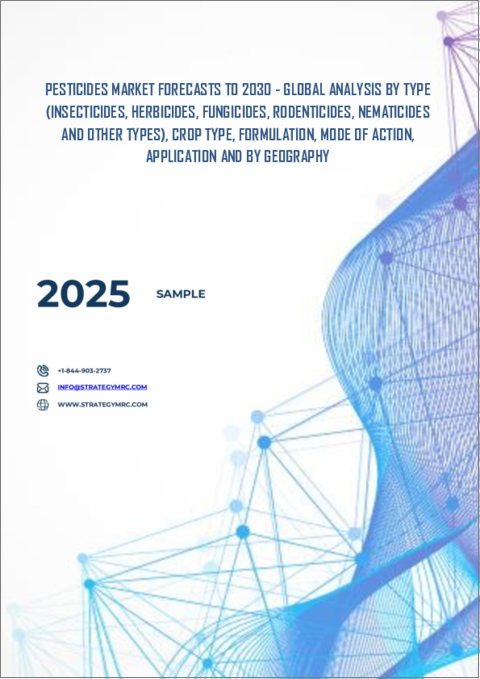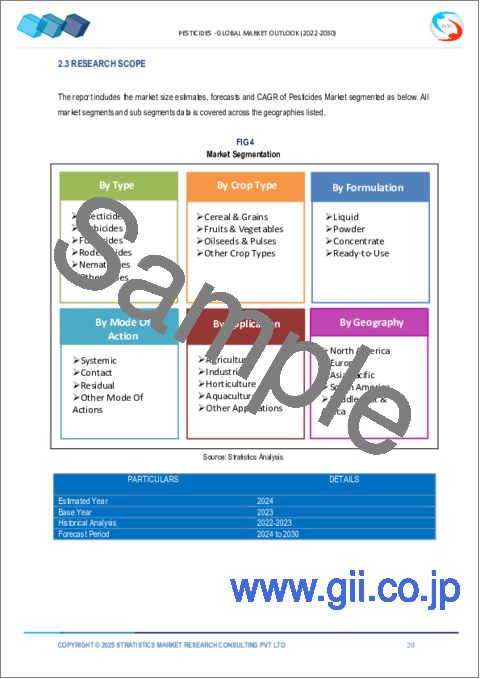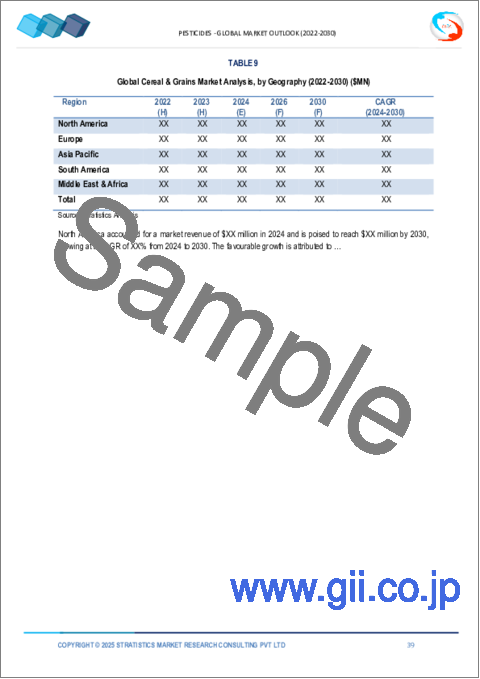|
|
市場調査レポート
商品コード
1530817
農薬市場の2030年までの予測: タイプ別、作物タイプ別、剤形別、作用機序別、用途別、地域別の世界分析Pesticides Market Forecasts to 2030 - Global Analysis By Type (Insecticides, Herbicides, Fungicides, Rodenticides, Nematicides and Other Types), Crop Type, Formulation, Mode Of Action, Application and By Geography |
||||||
カスタマイズ可能
|
|||||||
| 農薬市場の2030年までの予測: タイプ別、作物タイプ別、剤形別、作用機序別、用途別、地域別の世界分析 |
|
出版日: 2024年08月01日
発行: Stratistics Market Research Consulting
ページ情報: 英文 200+ Pages
納期: 2~3営業日
|
全表示
- 概要
- 図表
- 目次
Stratistics MRCによると、世界の農薬市場は2024年に473億5,000万米ドルを占め、予測期間中にCAGR 9.5%で成長し、2030年には906億5,000万米ドルに達すると予想されています。
農薬は、農作物、家畜、または人間の健康に害を及ぼす害虫を予防、駆除、駆除するために使用される化学薬品または生物製剤です。農薬は、農作物の品質と安全性を維持することによって、農作物の損失を減らし、食品媒介性疾患のリスクを低減するのに役立ちます。農薬はまた、農家が多様な環境で多種多様な作物を栽培することを可能にします。
環境保護庁(EPA)のデータによると、インド政府は総合的害虫管理(IPM)の一環として、文化的、機械的、生物学的害虫駆除法を用いた生物殺虫剤の使用を開始しました。IPMは中央総合害虫管理センター(CIPMCs)が農民学校(Farmers Field Schools)や研修などのプログラムを通じて推進しています。
近代的農業技術の導入拡大
精密農業や総合的病害虫管理など、近代的農業技術の導入が進むにつれ、害虫駆除の効率も向上しています。精密農業は、技術を利用して害虫をより正確に狙い撃ちし、農薬の使用量を削減すると同時に作物の収量を向上させる。総合的害虫管理は、化学的、生物学的、文化的手法を組み合わせて害虫駆除を最適化し、環境への影響を最小限に抑えます。こうした高度な技術は農薬散布の効果を高め、より高い生産性をサポートするため、革新的でカスタマイズされた農薬ソリューションへの需要を高めています。
環境と健康への懸念
農薬の使用は、土壌や水の汚染、非標的種への害、呼吸器障害やがんなどの人間の健康問題といった潜在的なリスクにより、環境や健康への懸念が生じる。こうした懸念は、規制の強化、監視の強化、より安全な代替品の推進につながっています。その結果、コンプライアンス・コストの上昇、特定の製品の入手可能性の低下、有機農法や持続可能な農法に対する消費者の需要によって、市場の成長が妨げられる可能性があります。
農薬製剤の革新
徐放性または標的送達システムなどの高度な製剤は、害虫駆除の効率を高め、必要な化学薬品の量を削減します。技術革新はまた、非標的生物に対する毒性が低く、環境への影響を低減した農薬の開発にもつながります。こうした進歩は持続可能な農業慣行を支え、より厳しい規制に適合します。製剤の改良は害虫抵抗性などの課題にも対処し、農薬をより効果的で農家にとって魅力的なものにします。その結果、こうした技術革新は採用拡大と市場拡大に寄与しています。
持続可能性と有機農業の動向
有機農業は自然な害虫駆除方法を重視し、従来の農薬を使用しないもので、環境にやさしく健康志向の製品を求める消費者の需要に後押しされています。このシフトは、農薬の使用量と市場需要の減少につながります。さらに、持続可能な慣行には、化学的解決策ではなく代替方法に頼る総合的害虫管理が含まれることが多いです。こうした手法を採用する農家が増えるにつれ、従来の農薬市場は縮小し、この分野全体の成長に影響を与えます。
COVID-19の影響
COVID-19の大流行は、サプライチェーンを混乱させ、生産や流通に遅れを生じさせることで、農薬市場に大きな影響を与えました。操業停止や規制は農業活動に影響を与え、特定の農薬の需要を減少させました。逆に、この危機は食糧安全保障の重要性を浮き彫りにし、作物保護ソリューションへの関心を高めることにつながった。市場では、より持続可能で革新的な防除方法へのシフトが見られました。全体として、パンデミックは短期的な課題を引き起こしたもの、農薬業界における効率性と持続可能性への動向を加速させました。
予測期間中、すぐ使える分野が最大となる見込み
既製農薬セグメントは有利な成長を遂げると推定されます。すぐに使える農薬は、あらかじめ混合された製剤であり、散布前に追加の準備や希釈を必要としないです。スプレーや顆粒のような便利な形状で、消費者が患部に直接塗布しやすいです。害虫駆除に最適なこれらの製品は、一般的な家庭や庭の害虫に効果的なソリューションを提供します。使いやすさと即効性が主な利点だが、潜在的な危険を避けるために安全に関する指示に従うことが重要です。
農業分野は予測期間中に最も高いCAGRが見込まれる
農業分野は、予測期間中に最も高いCAGR成長が見込まれます。農業用途の農薬は、害虫、病気、雑草から作物を守るために使用される化学薬品です。植物に害を与える不要な生物を駆除することで、作物の収量と品質を向上させる。しかし、その使用は、非標的種への潜在的な害、土壌の健康、水質汚染など、環境への影響に関する懸念を引き起こします。総合的有害生物管理(IPM)の実践は、生態系や人間の健康への悪影響を最小限に抑えつつ、効果のバランスをとることを目的としています。
最大のシェアを占める地域:
アジア太平洋地域は、農業活動の増加、食糧安全保障に対する需要の高まり、作物保護技術の進歩により、予測期間中最大の市場シェアを占めると予測されます。この成長を促進する主な要因としては、耕地面積の拡大、近代的農法の採用、農業開発を支援する政府の取り組みなどが挙げられます。中国やインドのような国々が市場を独占しており、収量の向上と害虫抵抗性の管理に力を入れています。また、環境に優しい農法が重視されるようになり、バイオ農薬や持続可能なソリューションへのシフトも見られます。
CAGRが最も高い地域:
北米は、先進的な農業慣行、高い作物収量需要、精密農業技術の採用増加により、予測期間中に最も高いCAGRを示すと予測されます。米国とカナダの規制枠組みは厳しく、製品開発と承認に影響を与えています。同地域の主要企業は、バイエル、コルテバ、シンジェンタなどです。市場は有機農業や持続可能な農業の動向にも影響を受けています。全体として、効率的で環境に優しい害虫駆除方法に対する需要の高まりが成長を支えています。
無料のカスタマイズサービス:
本レポートをご購読のお客様には、以下の無料カスタマイズオプションのいずれかをご利用いただけます:
- 企業プロファイル
- 追加市場プレーヤーの包括的プロファイリング(3社まで)
- 主要企業のSWOT分析(3社まで)
- 地域セグメンテーション
- 顧客の関心に応じた主要国の市場推計・予測・CAGR(注:フィージビリティチェックによる)
- 競合ベンチマーキング
- 製品ポートフォリオ、地理的プレゼンス、戦略的提携に基づく主要企業のベンチマーキング
目次
第1章 エグゼクティブサマリー
第2章 序文
- 概要
- ステークホルダー
- 調査範囲
- 調査手法
- データマイニング
- データ分析
- データ検証
- 調査アプローチ
- 調査情報源
- 1次調査情報源
- 2次調査情報源
- 前提条件
第3章 市場動向分析
- 促進要因
- 抑制要因
- 機会
- 脅威
- 用途分析
- 新興市場
- COVID-19の影響
第4章 ポーターのファイブフォース分析
- 供給企業の交渉力
- 買い手の交渉力
- 代替品の脅威
- 新規参入業者の脅威
- 競争企業間の敵対関係
第5章 世界の農薬市場:タイプ別
- 殺虫剤
- 除草剤
- 殺菌剤
- 殺鼠剤
- 殺線虫剤
- その他のタイプ
第6章 世界の農薬市場:作物タイプ別
- 穀類・穀物
- 果物・野菜
- 油糧種子・豆類
- その他の作物タイプ
第7章 世界の農薬市場:剤形別
- 液体
- 粉末
- 濃縮液
- RTU
第8章 世界の農薬市場:作用機序別
- 浸透
- 接触
- 残留
- その他の作用機序
第9章 世界の農薬市場:用途別
- 農業
- 産業
- 園芸
- 水産養殖業
- その他の用途
第10章 世界の農薬市場:地域別
- 北米
- 米国
- カナダ
- メキシコ
- 欧州
- ドイツ
- 英国
- イタリア
- フランス
- スペイン
- その他欧州
- アジア太平洋
- 日本
- 中国
- インド
- オーストラリア
- ニュージーランド
- 韓国
- その他アジア太平洋地域
- 南米
- アルゼンチン
- ブラジル
- チリ
- その他南米
- 中東・アフリカ
- サウジアラビア
- アラブ首長国連邦
- カタール
- 南アフリカ
- その他中東とアフリカ
第11章 主な発展
- 契約、パートナーシップ、コラボレーション、合弁事業
- 買収と合併
- 新製品発売
- 事業拡大
- その他の主要戦略
第12章 企業プロファイリング
- BASF SE
- Bayer AG
- Syngenta
- Corteva Agriscience
- FMC Corporation
- ADAMA Agricultural Solutions
- Nufarm Limited
- Sumitomo Chemical
- UPL Limited
- Arysta LifeScience
- Cheminova
- Albaugh LLC
- Sapec Agro
- Dow AgroSciences
- Monsanto
- Best Agrolife Limited
List of Tables
- Table 1 Global Pesticides Market Outlook, By Region (2022-2030) ($MN)
- Table 2 Global Pesticides Market Outlook, By Type (2022-2030) ($MN)
- Table 3 Global Pesticides Market Outlook, By Insecticides (2022-2030) ($MN)
- Table 4 Global Pesticides Market Outlook, By Herbicides (2022-2030) ($MN)
- Table 5 Global Pesticides Market Outlook, By Fungicides (2022-2030) ($MN)
- Table 6 Global Pesticides Market Outlook, By Rodenticides (2022-2030) ($MN)
- Table 7 Global Pesticides Market Outlook, By Nematicides (2022-2030) ($MN)
- Table 8 Global Pesticides Market Outlook, By Other Types (2022-2030) ($MN)
- Table 9 Global Pesticides Market Outlook, By Crop Type (2022-2030) ($MN)
- Table 10 Global Pesticides Market Outlook, By Cereal & Grains (2022-2030) ($MN)
- Table 11 Global Pesticides Market Outlook, By Fruits & Vegetables (2022-2030) ($MN)
- Table 12 Global Pesticides Market Outlook, By Oilseeds & Pulses (2022-2030) ($MN)
- Table 13 Global Pesticides Market Outlook, By Other Crop Types (2022-2030) ($MN)
- Table 14 Global Pesticides Market Outlook, By Formulation (2022-2030) ($MN)
- Table 15 Global Pesticides Market Outlook, By Liquid (2022-2030) ($MN)
- Table 16 Global Pesticides Market Outlook, By Powder (2022-2030) ($MN)
- Table 17 Global Pesticides Market Outlook, By Concentrate (2022-2030) ($MN)
- Table 18 Global Pesticides Market Outlook, By Ready-to-Use (2022-2030) ($MN)
- Table 19 Global Pesticides Market Outlook, By Mode Of Action (2022-2030) ($MN)
- Table 20 Global Pesticides Market Outlook, By Systemic (2022-2030) ($MN)
- Table 21 Global Pesticides Market Outlook, By Contact (2022-2030) ($MN)
- Table 22 Global Pesticides Market Outlook, By Residual (2022-2030) ($MN)
- Table 23 Global Pesticides Market Outlook, By Other Mode Of Actions (2022-2030) ($MN)
- Table 24 Global Pesticides Market Outlook, By Application (2022-2030) ($MN)
- Table 25 Global Pesticides Market Outlook, By Agricultural (2022-2030) ($MN)
- Table 26 Global Pesticides Market Outlook, By Industrial (2022-2030) ($MN)
- Table 27 Global Pesticides Market Outlook, By Horticulture (2022-2030) ($MN)
- Table 28 Global Pesticides Market Outlook, By Aquaculture (2022-2030) ($MN)
- Table 29 Global Pesticides Market Outlook, By Other Applications (2022-2030) ($MN)
Note: Tables for North America, Europe, APAC, South America, and Middle East & Africa Regions are also represented in the same manner as above.
According to Stratistics MRC, the Global Pesticides Market is accounted for $47.35 billion in 2024 and is expected to reach $90.65 billion by 2030 growing at a CAGR of 9.5% during the forecast period. Pesticides are chemicals or biological agents used to prevent, control, or eliminate pests that harm crops, livestock, or human health. They help reduce crop losses and lower the risk of food borne illnesses by maintaining the quality and safety of produce. Pesticides also enable farmers to grow a wider variety of crops in diverse environments.
According to the Environmental Protection Agency (EPA) data, India Government has initiated the use of bioinsecticides as part of Integrated Pest Management (IPM), employing cultural, mechanical, and biological pest control methods. It is promoted by Central Integrated Pest Management Centers (CIPMCs) through programs like Farmers Field Schools and training initiatives.
Market Dynamics:
Driver:
Increasing adoption of modern farming techniques
Increasing adoption of modern farming techniques, such as precision agriculture and integrated pest management, enhances pest control efficiency. Precision agriculture uses technology to target pests more accurately, reducing overall pesticide use while improving crop yields. Integrated pest management combines chemical, biological, and cultural methods to optimize pest control and minimize environmental impact. These advanced techniques increase the effectiveness of pesticide applications and support higher productivity, thereby boosting demand for innovative and tailored pesticide solutions.
Restraint:
Environmental and health concerns
Environmental and health concerns arise from pesticide use due to potential risks such as contamination of soil and water, harm to non-target species, and human health issues like respiratory problems and cancer. These concerns lead to stricter regulations, increased scrutiny, and the push for safer alternatives. As a result, market growth can be hampered by higher compliance costs, reduced availability of certain products, and consumer demand for organic and sustainable farming practices.
Opportunity:
Innovations in pesticide formulations
Advanced formulations, such as slow-release or targeted delivery systems, increase pest control efficiency and reduce the volume of chemicals needed. Innovations also lead to the development of pesticides with lower toxicity to non-target organisms and reduced environmental impact. These advancements support sustainable agricultural practices and comply with stricter regulations. Improved formulations also address challenges like pest resistance, making pesticides more effective and appealing to farmers. Consequently, these innovations contribute to increased adoption and market expansion.
Threat:
Sustainability and organic farming trends
Organic farming emphasizes natural pest control methods and avoids conventional pesticides, driven by consumer demand for eco-friendly and health-conscious products. This shift leads to a decrease in pesticide usage and market demand. Additionally, sustainable practices often involve integrated pest management, which relies on alternative methods rather than chemical solutions. As more farmers adopt these practices, the market for traditional pesticides contracts, impacting overall growth in the sector.
Covid-19 Impact
The covid-19 pandemic significantly impacted the pesticides market by disrupting supply chains, causing delays in production and distribution. Lockdowns and restrictions affected agricultural activities and reduced demand for certain pesticides. Conversely, the crisis highlighted the importance of food security, leading to increased interest in crop protection solutions. The market saw a shift towards more sustainable and innovative pest management practices. Overall, while the pandemic caused short-term challenges, it accelerated trends toward efficiency and sustainability in the pesticide industry.
The ready-to-use segment is expected to be the largest during the forecast period
The ready-to-use segment is estimated to have a lucrative growth. Ready-to-use pesticides are pre-mixed formulations that require no additional preparation or dilution before application. They come in convenient forms like sprays or granules, making them easy for consumers to apply directly to affected areas. Ideal for immediate pest control, these products offer effective solutions for common household and garden pests. Their ease of use and quick action are key benefits, though it's important to follow safety instructions to avoid potential hazards.
The agricultural segment is expected to have the highest CAGR during the forecast period
The agricultural segment is anticipated to witness the highest CAGR growth during the forecast period. Pesticides in agricultural applications are chemicals used to protect crops from pests, diseases, and weeds. They enhance crop yield and quality by controlling unwanted organisms that can damage plants. However, their use raises concerns about environmental impact, including potential harm to non-target species, soil health, and water contamination. Integrated Pest Management (IPM) practices aim to balance effectiveness with minimizing negative effects on ecosystems and human health.
Region with largest share:
Asia Pacific is projected to hold the largest market share during the forecast period due to increasing agricultural activities, rising demand for food security, and advancements in crop protection technologies. Key factors driving this growth include expanding arable land, adoption of modern farming practices, and government initiatives supporting agricultural development. Countries like China and India dominate the market, with a strong focus on enhancing yield and managing pest resistance. The market is also witnessing a shift towards bio-pesticides and sustainable solutions, reflecting a growing emphasis on eco-friendly practices.
Region with highest CAGR:
North America is projected to have the highest CAGR over the forecast period, owing to advanced agricultural practices, high crop yield demands, and increasing adoption of precision farming technologies. Regulatory frameworks in the U.S. and Canada are stringent, impacting product development and approval. Key players in the region include Bayer, Corteva, and Syngenta. The market is also influenced by trends in organic farming and sustainable agriculture. Overall, growth is supported by increasing demand for efficient and environmentally friendly pest control methods.
Key players in the market
Some of the key players profiled in the Pesticides Market include BASF SE, Bayer AG, Syngenta, Corteva Agriscience, FMC Corporation, ADAMA Agricultural Solutions, Nufarm Limited, Sumitomo Chemical, UPL Limited, Arysta LifeScience, Cheminova, Albaugh LLC, Sapec Agro, Dow AgroSciences, Monsanto and Best Agrolife Limited.
Key Developments:
In June 2024, Best Agrolife Ltd has launched its new patented insecticide formulation named Nemagen, designed to combat resistant pests causing significant crop damage. Nemagen contains a combination of active ingredients chlorantraniliprole, novaluron and emamectin benzoate to provide broad-spectrum control of lepidopteran, coleoptera and diptera pests affecting vegetables, grains, fruits and pulses.
In May 2024, BASF has launched Efficon, a new insecticide, in India to help farmers tackle sucking pests. Classified under the new IRAC group 36, the product represents a new class of insecticides (Group 36 - pyridazine) with no known cross-resistance with existing products, making it a superior insecticide resistance management tool.
Types Covered:
- Insecticides
- Herbicides
- Fungicides
- Rodenticides
- Nematicides
- Other Types
Crop Types Covered:
- Cereal & Grains
- Fruits & Vegetables
- Oilseeds & Pulses
- Other Crop Types
Formulations Covered:
- Liquid
- Powder
- Concentrate
- Ready-to-Use
Mode Of Actions Covered:
- Systemic
- Contact
- Residual
- Other Mode Of Actions
Applications Covered:
- Agricultural
- Industrial
- Horticulture
- Aquaculture
- Other Applications
Regions Covered:
- North America
- US
- Canada
- Mexico
- Europe
- Germany
- UK
- Italy
- France
- Spain
- Rest of Europe
- Asia Pacific
- Japan
- China
- India
- Australia
- New Zealand
- South Korea
- Rest of Asia Pacific
- South America
- Argentina
- Brazil
- Chile
- Rest of South America
- Middle East & Africa
- Saudi Arabia
- UAE
- Qatar
- South Africa
- Rest of Middle East & Africa
What our report offers:
- Market share assessments for the regional and country-level segments
- Strategic recommendations for the new entrants
- Covers Market data for the years 2022, 2023, 2024, 2026, and 2030
- Market Trends (Drivers, Constraints, Opportunities, Threats, Challenges, Investment Opportunities, and recommendations)
- Strategic recommendations in key business segments based on the market estimations
- Competitive landscaping mapping the key common trends
- Company profiling with detailed strategies, financials, and recent developments
- Supply chain trends mapping the latest technological advancements
Free Customization Offerings:
All the customers of this report will be entitled to receive one of the following free customization options:
- Company Profiling
- Comprehensive profiling of additional market players (up to 3)
- SWOT Analysis of key players (up to 3)
- Regional Segmentation
- Market estimations, Forecasts and CAGR of any prominent country as per the client's interest (Note: Depends on feasibility check)
- Competitive Benchmarking
- Benchmarking of key players based on product portfolio, geographical presence, and strategic alliances
Table of Contents
1 Executive Summary
2 Preface
- 2.1 Abstract
- 2.2 Stake Holders
- 2.3 Research Scope
- 2.4 Research Methodology
- 2.4.1 Data Mining
- 2.4.2 Data Analysis
- 2.4.3 Data Validation
- 2.4.4 Research Approach
- 2.5 Research Sources
- 2.5.1 Primary Research Sources
- 2.5.2 Secondary Research Sources
- 2.5.3 Assumptions
3 Market Trend Analysis
- 3.1 Introduction
- 3.2 Drivers
- 3.3 Restraints
- 3.4 Opportunities
- 3.5 Threats
- 3.6 Application Analysis
- 3.7 Emerging Markets
- 3.8 Impact of Covid-19
4 Porters Five Force Analysis
- 4.1 Bargaining power of suppliers
- 4.2 Bargaining power of buyers
- 4.3 Threat of substitutes
- 4.4 Threat of new entrants
- 4.5 Competitive rivalry
5 Global Pesticides Market, By Type
- 5.1 Introduction
- 5.2 Insecticides
- 5.3 Herbicides
- 5.4 Fungicides
- 5.5 Rodenticides
- 5.6 Nematicides
- 5.7 Other Types
6 Global Pesticides Market, By Crop Type
- 6.1 Introduction
- 6.2 Cereal & Grains
- 6.3 Fruits & Vegetables
- 6.4 Oilseeds & Pulses
- 6.5 Other Crop Types
7 Global Pesticides Market, By Formulation
- 7.1 Introduction
- 7.2 Liquid
- 7.3 Powder
- 7.4 Concentrate
- 7.5 Ready-to-Use
8 Global Pesticides Market, By Mode Of Action
- 8.1 Introduction
- 8.2 Systemic
- 8.3 Contact
- 8.4 Residual
- 8.5 Other Mode Of Actions
9 Global Pesticides Market, By Application
- 9.1 Introduction
- 9.2 Agricultural
- 9.3 Industrial
- 9.4 Horticulture
- 9.5 Aquaculture
- 9.6 Other Applications
10 Global Pesticides Market, By Geography
- 10.1 Introduction
- 10.2 North America
- 10.2.1 US
- 10.2.2 Canada
- 10.2.3 Mexico
- 10.3 Europe
- 10.3.1 Germany
- 10.3.2 UK
- 10.3.3 Italy
- 10.3.4 France
- 10.3.5 Spain
- 10.3.6 Rest of Europe
- 10.4 Asia Pacific
- 10.4.1 Japan
- 10.4.2 China
- 10.4.3 India
- 10.4.4 Australia
- 10.4.5 New Zealand
- 10.4.6 South Korea
- 10.4.7 Rest of Asia Pacific
- 10.5 South America
- 10.5.1 Argentina
- 10.5.2 Brazil
- 10.5.3 Chile
- 10.5.4 Rest of South America
- 10.6 Middle East & Africa
- 10.6.1 Saudi Arabia
- 10.6.2 UAE
- 10.6.3 Qatar
- 10.6.4 South Africa
- 10.6.5 Rest of Middle East & Africa
11 Key Developments
- 11.1 Agreements, Partnerships, Collaborations and Joint Ventures
- 11.2 Acquisitions & Mergers
- 11.3 New Product Launch
- 11.4 Expansions
- 11.5 Other Key Strategies
12 Company Profiling
- 12.1 BASF SE
- 12.2 Bayer AG
- 12.3 Syngenta
- 12.4 Corteva Agriscience
- 12.5 FMC Corporation
- 12.6 ADAMA Agricultural Solutions
- 12.7 Nufarm Limited
- 12.8 Sumitomo Chemical
- 12.9 UPL Limited
- 12.10 Arysta LifeScience
- 12.11 Cheminova
- 12.12 Albaugh LLC
- 12.13 Sapec Agro
- 12.14 Dow AgroSciences
- 12.15 Monsanto
- 12.16 Best Agrolife Limited





